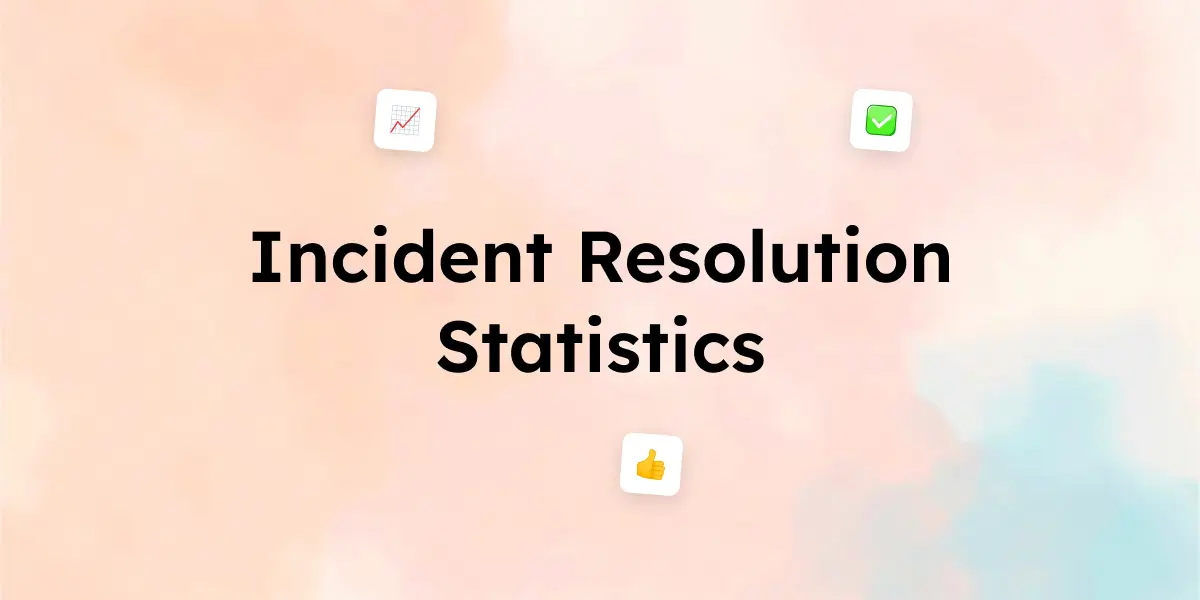Efficient incident resolution is critical for IT teams to maintain business continuity, minimize downtime, and improve user satisfaction. With increasing reliance on cloud services, remote work, and AI-driven IT support, organizations must track key metrics to optimize their incident management processes.
This article presents 35 essential statistics that highlight the latest trends, resolution times, escalation patterns, automation impact, and future predictions for IT incident management in 2025. These insights will help IT leaders enhance their Service Level Agreements (SLAs), optimize workflows, and leverage AI for faster resolutions.
35 Incident Resolution Statistics
1. General Incident Management Statistics
- 70% of IT teams report an increase in incidents due to remote work challenges.
- 80% of organizations use ITSM (IT Service Management) tools to track incidents.
- 60% of IT leaders say AI and automation have improved incident resolution speed.
- 85% of incidents are caused by human error or misconfigurations.
- 45% of IT professionals believe their teams are understaffed for effective incident resolution.
2. Incident Volume & Trends
- The average IT team handles 50–200 incidents per month, depending on company size.
- 42% of incidents are service requests, while 58% are true incidents.
- 30% of IT incidents are repetitive and could be automated.
- 25% increase in cybersecurity-related incidents compared to previous years.
- 55% of incidents are reported by end-users, while the rest are detected by monitoring systems.
3. Incident Resolution Speed & SLAs (Service Level Agreements)
- The average resolution time for a critical incident is 4–8 hours.
- 78% of IT teams meet their SLA resolution time consistently.
- 20% of tickets exceed SLA time due to lack of resources or prioritization issues.
- First-response time averages 15–45 minutes for high-priority incidents.
- 68% of IT incidents are resolved on the first attempt (First Call Resolution – FCR).
4. Impact of AI & Automation on Incident Resolution
- IT teams using AI-powered automation resolve incidents 30% faster.
- Chatbots and virtual assistants handle 25% of IT support tickets without human intervention.
- Self-healing systems reduce repetitive incident tickets by 40%.
- Predictive analytics help prevent 35% of major incidents before they occur.
- Machine learning models accurately classify incidents with 92% accuracy.
5. Escalation & Severity Metrics
- 15% of incidents require escalation to Level 2 or Level 3 support.
- The mean time to escalate (MTTE) for unresolved issues is 1.5 hours.
- Major incidents (P1) account for 5% of total incidents but take 4x longer to resolve.
- 60% of major incidents involve third-party service providers (e.g., cloud vendors).
- Incident post-mortems are conducted for 90% of major incidents to improve processes.
6. User Satisfaction & IT Support Efficiency
- End-user satisfaction with IT support is 85% on average.
- 92% of users expect a response within an hour for critical IT issues.
- 30% of IT support calls could be resolved using a knowledge base or self-service portal.
- IT teams with strong documentation resolve incidents 25% faster.
- Automated ticket triaging reduces misassigned tickets by 50%.
7. Future Trends in Incident Resolution (2025 & Beyond)
- 50% of IT teams are integrating generative AI for real-time ticket analysis.
- Blockchain-based logging is improving IT security incident tracking.
- Remote-first incident resolution is the new standard, with 75% of teams operating fully remotely.
- ITSM platforms with predictive analytics reduce incident rates by 20% annually.
- AI-driven IT support is projected to handle 40% of all incidents by 2027.
Key Takeaways for IT Teams
- AI, automation, and self-service tools are reshaping incident management efficiency.
- Faster resolution times and improved user satisfaction depend on streamlined IT processes.
- Major incidents remain a challenge, requiring better prevention, escalation handling, and root-cause analysis.
- Future trends include predictive analytics, AI-driven support, and blockchain-based security solutions.
Conclusion
IT incident management is evolving rapidly with AI, automation, and predictive analytics improving response times and efficiency. The key trends show that organizations adopting self-service portals, AI-driven chatbots, and automated workflows can significantly reduce resolution times while enhancing user satisfaction.
Moving forward, IT teams must focus on preventive incident management, leveraging predictive analytics and AI-powered triaging to reduce escalations and improve first-call resolution rates. Staying ahead of these trends will help IT teams become more proactive rather than reactive, ensuring seamless business operations.
Frequently Asked Questions (FAQs)
1. What is the average resolution time for IT incidents in 2025?
The average resolution time for critical IT incidents ranges from 4 to 8 hours, while minor incidents are resolved within 1–3 hours depending on severity and automation level.
2. How does AI improve IT incident resolution?
AI-powered automation reduces incident resolution time by 30%, improves ticket classification accuracy to 92%, and helps prevent 35% of major incidents through predictive analytics.
3. What percentage of IT incidents are caused by human error?
Approximately 85% of IT incidents result from human errors, such as misconfigurations, improper updates, or end-user mistakes.
4. What is the most common cause of IT incidents?
The top causes include misconfigurations, software bugs, cybersecurity threats, hardware failures, and third-party service outages.
5. How can IT teams reduce incident resolution times?
Key strategies include AI-powered automation, self-service knowledge bases, better documentation, proactive monitoring, and efficient escalation workflows.
ITIL 4 Foundation Guide
Forrester Research: The State of IT Automation 2025
IBM AI for IT Operations (AIOps) Report



